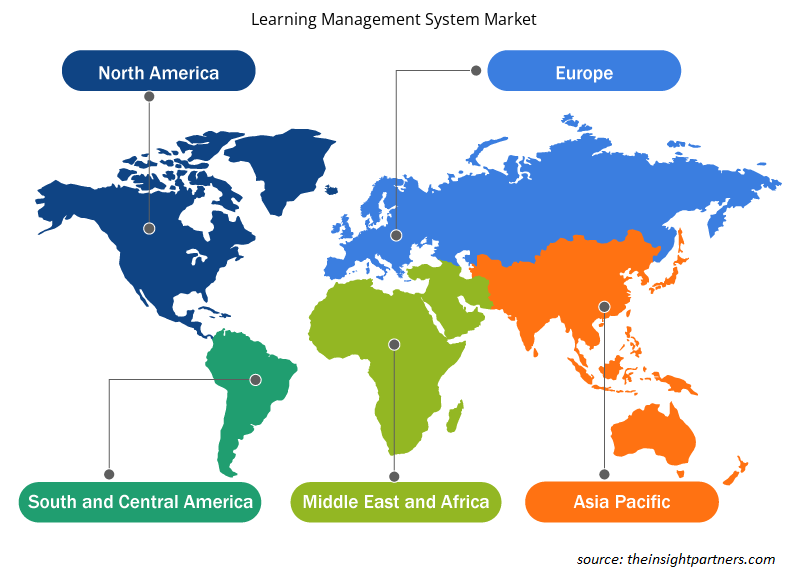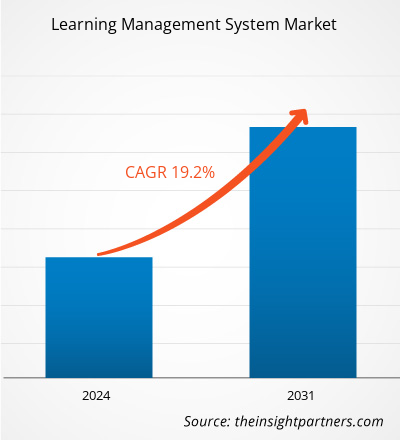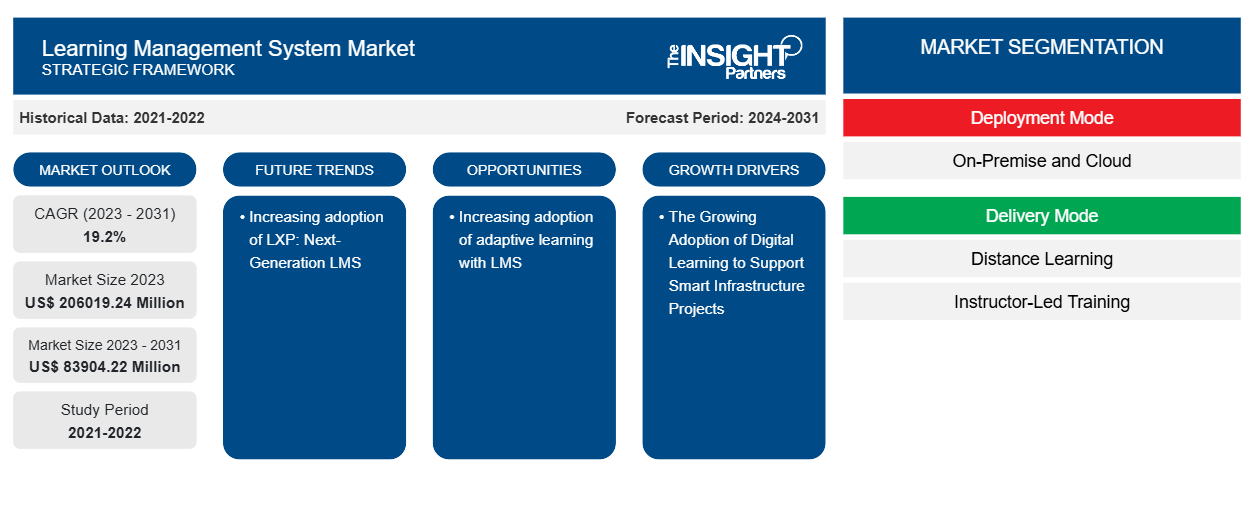Der Markt für Lernmanagementsysteme soll von 206.019,24 Millionen US-Dollar im Jahr 2023 auf 83.904,22 Millionen US-Dollar im Jahr 2031 anwachsen. Der Markt soll zwischen 2023 und 2031 eine durchschnittliche jährliche Wachstumsrate (CAGR) von 19,2 % verzeichnen. Die zunehmende Einführung von LXP: LMS der nächsten Generation wird wahrscheinlich ein wichtiger Trend auf dem Markt bleiben.
Marktanalyse für Lernmanagementsysteme
In den letzten Jahren ist der Markt für Lernmanagementsysteme gewachsen und hat sich erheblich verändert. Da sie es ermöglichen, Bildungsinhalte effizient zu verwalten und bereitzustellen, sind Lernmanagementsystemplattformen heute für Unternehmen, Bildungseinrichtungen und Online-Lernanbieter unverzichtbar. Die zunehmende Akzeptanz von Fernlern- und E-Learning-Methoden hat zu einer spürbaren Nachfragesteigerung auf dem Markt geführt. Der LMS-Markt ist aufgrund vieler Variablen im Zusammenhang mit der Marktdynamik gewachsen. Die Nachfrage nach LMS-Plattformen ist aufgrund der Fortschritte bei Online-Bildung und Fernlernprogrammen gestiegen, die durch den Bedarf an anpassbaren und zugänglichen Lernlösungen getrieben werden. Darüber hinaus hat die Unternehmenswelt erkannt, wie wertvoll LMS-Plattformen für die Schulung und Weiterbildung von Mitarbeitern sind, was zu einem Anstieg ihrer Nutzung am Arbeitsplatz geführt hat.
Marktübersicht zu Lernmanagementsystemen
Organisationen jeder Größe können ein Lernmanagementsystem als wirksames Softwaretool für die berufliche Weiterentwicklung und Schulung während des Onboardingprozesses von Mitarbeitern nutzen. Da viele LMS-Plattformen in der Cloud gehostet werden, ist ein Fernzugriff möglich. Die Datenbankverwaltung wird in einem LMS mit einer digitalen Architektur kombiniert, um die Verwaltung von Kursen, Zeitplänen, Schulungsmaterialien, Bewertungen und mehr zu erleichtern.
Passen Sie diesen Bericht Ihren Anforderungen an
Sie erhalten kostenlos individuelle Anpassungen an jedem Bericht, einschließlich Teilen dieses Berichts oder einer Analyse auf Länderebene, eines Excel-Datenpakets sowie tolle Angebote und Rabatte für Start-ups und Universitäten.
- Holen Sie sich die wichtigsten Markttrends aus diesem Bericht.Dieses KOSTENLOSE Beispiel umfasst eine Datenanalyse von Markttrends bis hin zu Schätzungen und Prognosen.
Markttreiber und Chancen für Lernmanagementsysteme
Die zunehmende Nutzung digitalen Lernens zur Unterstützung intelligenter Infrastrukturprojekte
Der Markt für Cloud-Sicherheit bietet aufgrund der zunehmenden Nutzung von Cloud-basierten Diensten verschiedene potenzielle Perspektiven. Die Nutzung von Cloud-basierten Diensten wird durch ihre Vorteile vorangetrieben, zu denen Skalierbarkeit, Flexibilität und Erschwinglichkeit gehören. Mit der zunehmenden Verbreitung von Cloud-basierten Diensten sind jedoch auch die Sicherheitsrisiken, darunter Datenlecks und Cyberangriffe, gestiegen. Um diesen Bedrohungen entgegenzuwirken, sind jetzt bessere Sicherheitslösungen erforderlich. Als Reaktion auf diese Anforderung wird erwartet, dass der Cloud-Sicherheitsmarkt schnell wächst. Das Marktwachstum wird voraussichtlich erheblich von den Kategorien SaaS und IaaS beeinflusst. Die Skalierbarkeit, Flexibilität und Kosteneffizienz dieser Lösungen sind einige der vielen Vorteile, die ihren Einsatz fördern.cyberattacks have also grown. Better security solutions are now required in order to counter these threats. In response to this requirement, the cloud security market is anticipated to expand rapidly. The market's growth is anticipated to be considerably impacted by the SaaS and IaaS categories. The scalability, flexibility, and cost-effectiveness of these solutions are among the many advantages that encourage their use.
Zunehmende Akzeptanz von adaptivem Lernen mit LMSLMS
Durch den Einsatz von Adaptive Learning im LMS werden die Studierenden zu Protagonisten und Leitern ihrer Vorbereitung. Nachdem sie Zugriff auf die eLearning-Site erhalten haben, können die Studierenden ihren Lernpfad basierend auf den Bewertungsergebnissen wählen . Anschließend kann die LMS-Plattform jedem Studierenden Informationen bereitstellen, die speziell auf seinen Lernstil zugeschnitten sind, ihm dabei helfen, die Bereiche zu identifizieren und zu verbessern, in denen er sich verbessern muss, oder alle unklaren Fragen oder Themen ansprechen. Damit die Benutzer Vertrauen in die Plattform und ihre Trainer entwickeln, ist diese Strategie unerlässlich. Um die eLearning-Ausbildung und das Engagement für die Ziele der Benutzer zu verbessern, wird in LMSs adaptives Lernen eingesetzt. Die zunehmende Einführung von adaptivem Lernen mit LMS schafft also mehr Möglichkeiten für den Markt.LMS, students will be protagonists and leaders of their preparation. Students will be able to choose their eLearning site. After that, the LMS platform might give each student information that is specifically tailored to their learning style, assist them in identifying and improving the areas in which they need to improve, or address any ambiguous queries or topics. For users to develop confidence in both the platform and their trainers, this strategy is essential. To increase eLearning education and devotion to the user's goals, adaptive learning is being used in LMSs. Thus, the increasing adoption of adaptive learning with LMS is creating more opportunities for the market.
Marktbericht zum Lernmanagementsystem – Segmentierungsanalyse
Wichtige Segmente, die zur Ableitung der Marktanalyse für Lernmanagementsysteme beigetragen haben, sind Bereitstellungsmodus, Liefermodus und Endbenutzer.
- Basierend auf dem Bereitstellungsmodus ist der Markt für Lernmanagementsysteme in On-Premise und Cloud unterteilt. Das Cloud-Segment hatte im Jahr 2023 einen größeren Marktanteil.
- Nach Bereitstellungsmodus ist der Markt in Fernunterricht, lehrergeführte Schulungen und Sonstiges segmentiert.
- Nach Endbenutzer ist der Markt in die Bereiche K-12, Hochschulbildung und Unternehmen segmentiert.
Marktanteilsanalyse für Lernmanagementsysteme nach geografischer Lage
Der geografische Umfang des Marktberichts zum Lernmanagementsystem ist hauptsächlich in fünf Regionen unterteilt: Nordamerika, Asien-Pazifik, Europa, Naher Osten und Afrika sowie Süd- und Mittelamerika.
Nordamerika dominiert den Markt für Lernmanagementsysteme. Der Markt für Lernmanagementsysteme (LMS) ist in den letzten Jahren erheblich gewachsen, wobei Nordamerika einen großen Beitrag zu dieser Expansion geleistet hat. Führende Technologieunternehmen in der Region haben erhebliche Investitionen in Infrastruktur und Technologie getätigt, was zur Entwicklung anspruchsvollerer und wirtschaftlicherer LMS-Lösungen geführt hat. Die erbitterte Rivalität auf dem nordamerikanischen Markt hat auch zur Entwicklung zugänglicherer Lernmanagementsysteme (LMS) mit einer Vielzahl von Merkmalen und Funktionen geführt, darunter soziales Lernen und Gamification.LMS) market has grown significantly in the last several years, with North America being a major contributor to this expansion. Leading technology companies in the region have made significant investments in infrastructure and technology, resulting in the development of more sophisticated and economical LMS solutions. The fierce rivalry in the North American market has also prompted the creation of more approachable learning management systems (LMS) with a variety of features and functionalities, including social learning and gamification.
Regionale Einblicke in den Markt für Lernmanagementsysteme
Die regionalen Trends und Faktoren, die den Markt für Lernmanagementsysteme im Prognosezeitraum beeinflussen, wurden von den Analysten von Insight Partners ausführlich erläutert. In diesem Abschnitt werden auch die Marktsegmente und die Geografie von Lernmanagementsystemen in Nordamerika, Europa, im asiatisch-pazifischen Raum, im Nahen Osten und Afrika sowie in Süd- und Mittelamerika erörtert.

- Erhalten Sie regionale Daten zum Markt für Lernmanagementsysteme
Umfang des Marktberichts zum Lernmanagementsystem
| Berichtsattribut | Details |
|---|---|
| Marktgröße im Jahr 2023 | 206019,24 Millionen US-Dollar |
| Marktgröße bis 2031 | 83.904,22 Millionen US-Dollar |
| Globale CAGR (2023 - 2031) | 19,2 % |
| Historische Daten | 2021-2022 |
| Prognosezeitraum | 2024–2031 |
| Abgedeckte Segmente | Nach Bereitstellungsmodus
|
| Abgedeckte Regionen und Länder | Nordamerika
|
| Marktführer und wichtige Unternehmensprofile |
|
Dichte der Marktteilnehmer für Lernmanagementsysteme: Die Auswirkungen auf die Geschäftsdynamik verstehen
Der Markt für Lernmanagementsysteme wächst rasant, angetrieben durch die steigende Nachfrage der Endnutzer aufgrund von Faktoren wie sich entwickelnden Verbraucherpräferenzen, technologischen Fortschritten und einem größeren Bewusstsein für die Vorteile des Produkts. Mit steigender Nachfrage erweitern Unternehmen ihr Angebot, entwickeln Innovationen, um die Bedürfnisse der Verbraucher zu erfüllen, und nutzen neue Trends, was das Marktwachstum weiter ankurbelt.
Die Marktteilnehmerdichte bezieht sich auf die Verteilung der Firmen oder Unternehmen, die in einem bestimmten Markt oder einer bestimmten Branche tätig sind. Sie gibt an, wie viele Wettbewerber (Marktteilnehmer) in einem bestimmten Marktraum im Verhältnis zu seiner Größe oder seinem gesamten Marktwert präsent sind.
Die wichtigsten auf dem Markt für Lernmanagementsysteme tätigen Unternehmen sind:
- Blackboard Inc.
- Grundstein
- D2L-Unternehmen
- Docebo
- Internationale Business Machines Corporation
- itslearning AS
Haftungsausschluss : Die oben aufgeführten Unternehmen sind nicht in einer bestimmten Reihenfolge aufgeführt.

- Überblick über die wichtigsten Akteure auf dem Markt für Lernmanagementsysteme
Neuigkeiten und aktuelle Entwicklungen zum Markt für Lernmanagementsysteme
Der Markt für Lernmanagementsysteme wird durch die Erhebung qualitativer und quantitativer Daten nach Primär- und Sekundärforschung bewertet, die wichtige Unternehmenspublikationen, Verbandsdaten und Datenbanken umfasst. Nachfolgend sind einige der Entwicklungen auf dem Markt für Lernmanagementsysteme aufgeführt:
- FSSC hat eine neue Kooperation mit MobieTrain angekündigt, einer mobilen Lernplattform, die das Training in ein unterhaltsames Erlebnis verwandeln wird. Diese Veränderung anzunehmen, eröffnet uns eine Welt voller Möglichkeiten. Mit hochmodernen Funktionen und benutzerfreundlichen Schnittstellen betritt das Unternehmen einen Bereich, in dem Lernen zugänglicher, spannender und interaktiver wird als je zuvor! In diesem 30-Sekunden-Video erhalten Sie einen ersten Einblick. (Quelle: FSSC, Pressemitteilung, April 2024.)
- Alison, die weltweit größte kostenlose Online-Empowerment-Plattform, hat die Einführung ihres revolutionären Free Learning Management Systems (Free LMS) angekündigt. Es wurde entwickelt, um die Kompetenzschulung für Organisationen jeder Größe zu demokratisieren, auch für solche mit begrenztem Budget. (Quelle: Mitsubishi Electric, Pressemitteilung, Februar 2024)
Marktbericht zu Lernmanagementsystemen – Umfang und Ergebnisse
Der Bericht „Marktgröße und Prognose für Lernmanagementsysteme (2021–2031)“ bietet eine detaillierte Analyse des Marktes, die die folgenden Bereiche abdeckt:
- Marktgröße und Prognose für Lernmanagementsysteme auf globaler, regionaler und Länderebene für alle wichtigen Marktsegmente, die im Rahmen des Berichts abgedeckt sind
- Markttrends für Lernmanagementsysteme sowie Marktdynamik wie Treiber, Einschränkungen und wichtige Chancen
- Detaillierte PEST/Porters Five Forces- und SWOT-Analyse
- Marktanalyse für Lernmanagementsysteme, die wichtige Markttrends, globale und regionale Rahmenbedingungen, wichtige Akteure, Vorschriften und aktuelle Marktentwicklungen umfasst
- Branchenlandschaft und Wettbewerbsanalyse, die die Marktkonzentration, Heatmap-Analyse, prominente Akteure und aktuelle Entwicklungen für den Markt für Lernmanagementsysteme umfasst
- Detaillierte Firmenprofile
- Historische Analyse (2 Jahre), Basisjahr, Prognose (7 Jahre) mit CAGR
- PEST- und SWOT-Analyse
- Marktgröße Wert/Volumen – Global, Regional, Land
- Branchen- und Wettbewerbslandschaft
- Excel-Datensatz
Aktuelle Berichte
Verwandte Berichte
Erfahrungsberichte
Grund zum Kauf
- Fundierte Entscheidungsfindung
- Marktdynamik verstehen
- Wettbewerbsanalyse
- Kundeneinblicke
- Marktprognosen
- Risikominimierung
- Strategische Planung
- Investitionsbegründung
- Identifizierung neuer Märkte
- Verbesserung von Marketingstrategien
- Steigerung der Betriebseffizienz
- Anpassung an regulatorische Trends





















 Kostenlose Probe anfordern für - Markt für Lernmanagementsysteme
Kostenlose Probe anfordern für - Markt für Lernmanagementsysteme